The nudity of the 400 Pueblos
From the archives: How peasant farmers unleashed the power of nudity in their struggle for indigenous land rights and justice
Editor’s note: This article was first published in May 2023 as an exclusive just for paid subscribers. Today we’re opening it up for the first time to free readers. Enjoy!
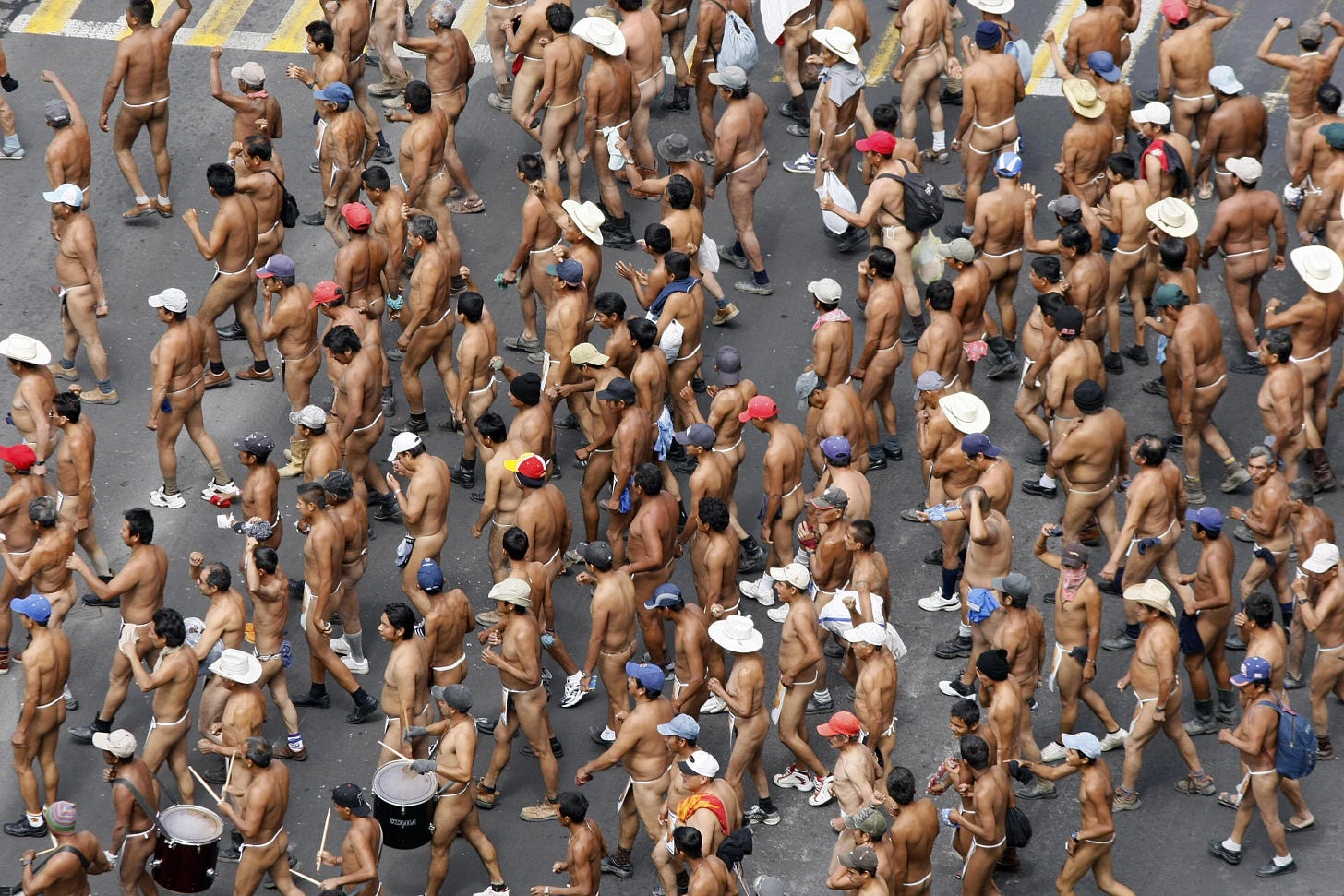
In 1970, the 400 Pueblos movement was born in Veracruz, Mexico, when a diverse group of 1,000 peasants from various indigenous communities and political parties embarked on a march from Coatepec to Mexico City, demanding the restoration of their unjustly taken land rights by the government. However, their march was abruptly halted by the military in Tlaxcala, resulting in the arrest of organizers on questionable charges, and their 19 day detention.
The injustice galvanized the movement, which was officially established in Veracruz upon their release, led in large part by organizer César del Ángel Fuentes.1
The 400 Pueblos movement found its roots in the historic 1970 march, and for fifty years, this politically active collective of indigenous communities in Veracruz has not only protested the government's neglect and exploitation of their land and resources, but has done so with the striking and controversial tactic of protesting nude.
But the 400 Pueblos movement didn’t always embrace nudity in their approach to activism. That developed out of desperation, emerging as a winning tactic that would garner global attention to the group’s broader message, and ultimately inspire copycat protests by other activist groups looking to replicate their success.
“In Mexico, you need at least 5,000 people in a movement to be noticed by the government… We don’t have that many people, so instead we get naked to attract attention to our cause.”
- César del Ángel Fuentes
Over the decades, their struggle has been met with harassment, imprisonment, and political retaliation. But as their leaders faced arrest warrants and their movement has suffered losses, the fate of the 400 Pueblos movement today hangs in the balance.
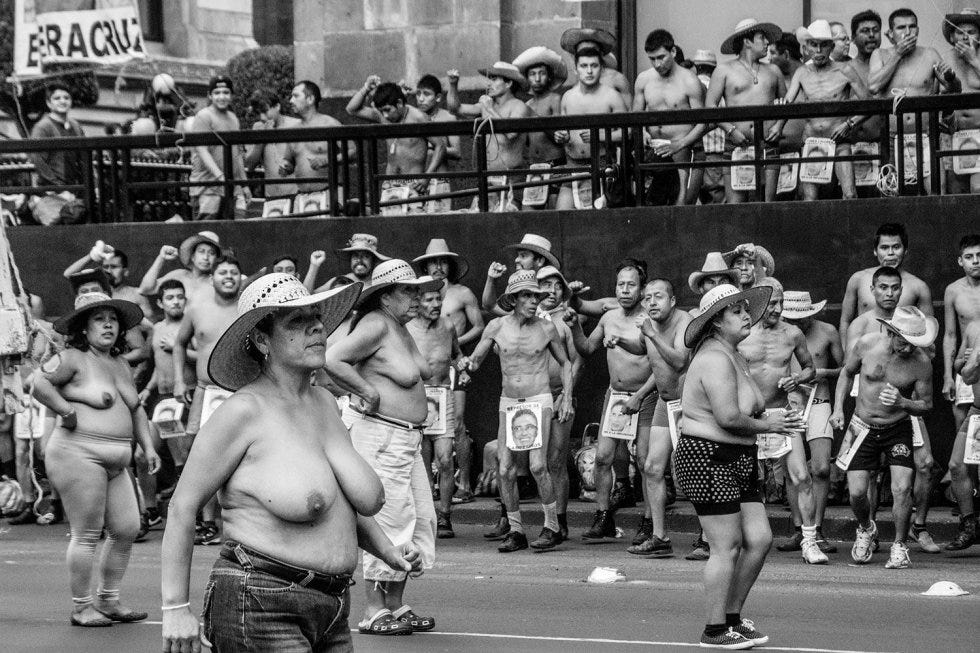
The rise of the Pueblos
The 400 Pueblos movement achieved a significant victory in 1974 when they received 10,000 hectares of land, enabling the creation of several communities. However, a commitment made in 1989 by President Salinas de Gortari to provide an additional 80,000 hectares was not fulfilled.
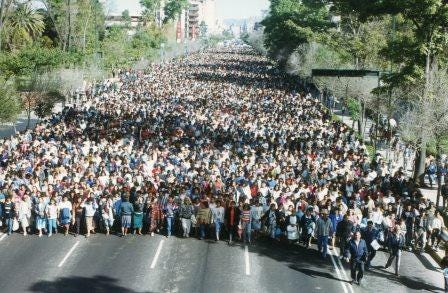
This dispute led to deaths, injuries, land seizures, crop destruction, and the imprisonment of over 350 activists. The movement's focus shifted from land rights to seeking justice for their comrades, accusing politicians like Miguel Ángel Yunes of repression and looting.2 This would lead to alleged retribution against the peasant leaders of the movement from Yunes’ government.3
Nothing left to lose
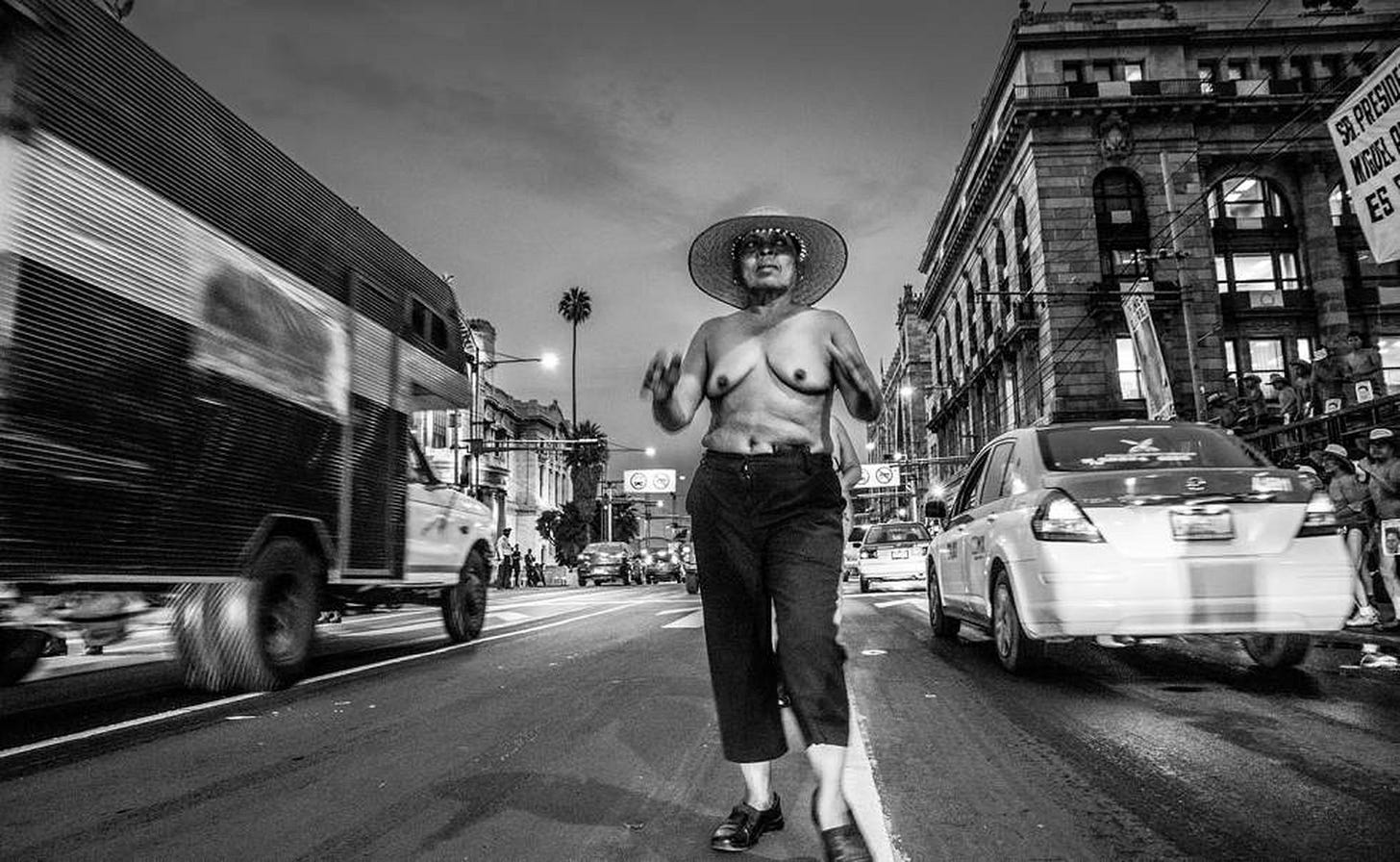
In 2002, the movement reached a pivotal moment when, frustrated that their hunger strike was not provoking action and driven by desperation to bring attention to their cause, the women of the 400 Pueblos movement decided to doff their clothes and engage in nude protests. This audacious act, led by Alfonsina Sandoval Urbina, leader of the Women's Assembly of the National Movement of the 400 Pueblos, defied societal norms and pushed the boundaries of traditional Mexican conservatism.
By exposing their bodies, these women intended to lay bare the vulnerability and defenselessness of their communities, shedding light on the government's exploitation and disregard for their rights. The stark imagery of their naked bodies became a powerful symbol of resistance and a call to action for the protection and recognition of marginalized communities. Tactical nudity was soon embraced by the rest of the group, including the men.
The adoption of nudity as a form of protest marked the most active and visible phase of the 400 Pueblos movement. Their biannual visits to Mexico City became a ritual, with women dancing topless and men wearing loincloths depicting the faces of alleged corrupt politicians. Often their protests were festive, with hundreds of nude or seminude participants dancing to thumping cumbia music in the streets.4
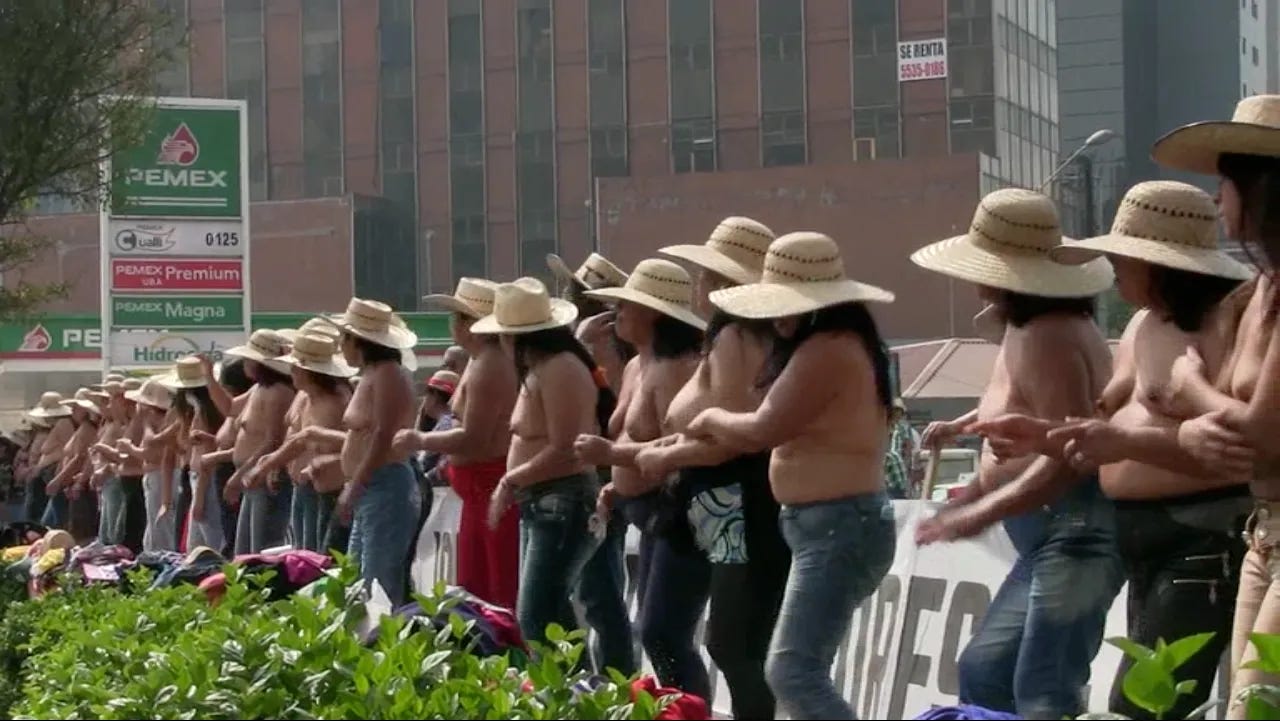
Their protests disrupted the status quo, demanding attention from both the government and the public. Despite facing harassment, imprisonment, and public censure, the movement remained steadfast in their cause.
The impact of the 400 Pueblos movement extended beyond the boundaries of Veracruz. Their audacity inspired other marginalized groups to adopt similar tactics in their struggles against governmental apathy.
Blows dealt
The movement has suffered blows in the last ten years, as leaders have been targeted and harassed by police. César del Ángel Fuentes faced multiple arrests and served prison time, allegedly as an attempt to silence the movement, most recently in 2017, when the State Attorney General's Office requested an arrest warrant against César del Ángel in response to a complaint filed by the Government of Veracruz. The arrest was seen by his relatives as political retaliation for his actions against Miguel Ángel Yunes. César del Ángel had been previously detained in 1992 but was released on bail in 2018 after winning a federal injunction.
“Today as the capital's government authorities threaten to repress us… I feel more naked because in addition to denying us the right to land, they don't accept us as citizens”
- Alfonsina Sandoval Urbina5
As recently as 2019, César del Ángel indicated that the State Attorney General's Office had carried out more than 60 arrest warrants against members of their movement using false charges.6 Alfonsina Sandoval Urbina was also arrested twice by the State Attorney General's Office in Veracruz in 2017 and 2019,7 but released both times due to insufficient evidence. 8
The movement was rocked on July 8, 2020, when César del Ángel Fuentes passed away at age 799 reportedly from respiratory failure and a kidney problem.10 Then Alfonsina Sandoval Urbina passed away in 2021 from an infection.11
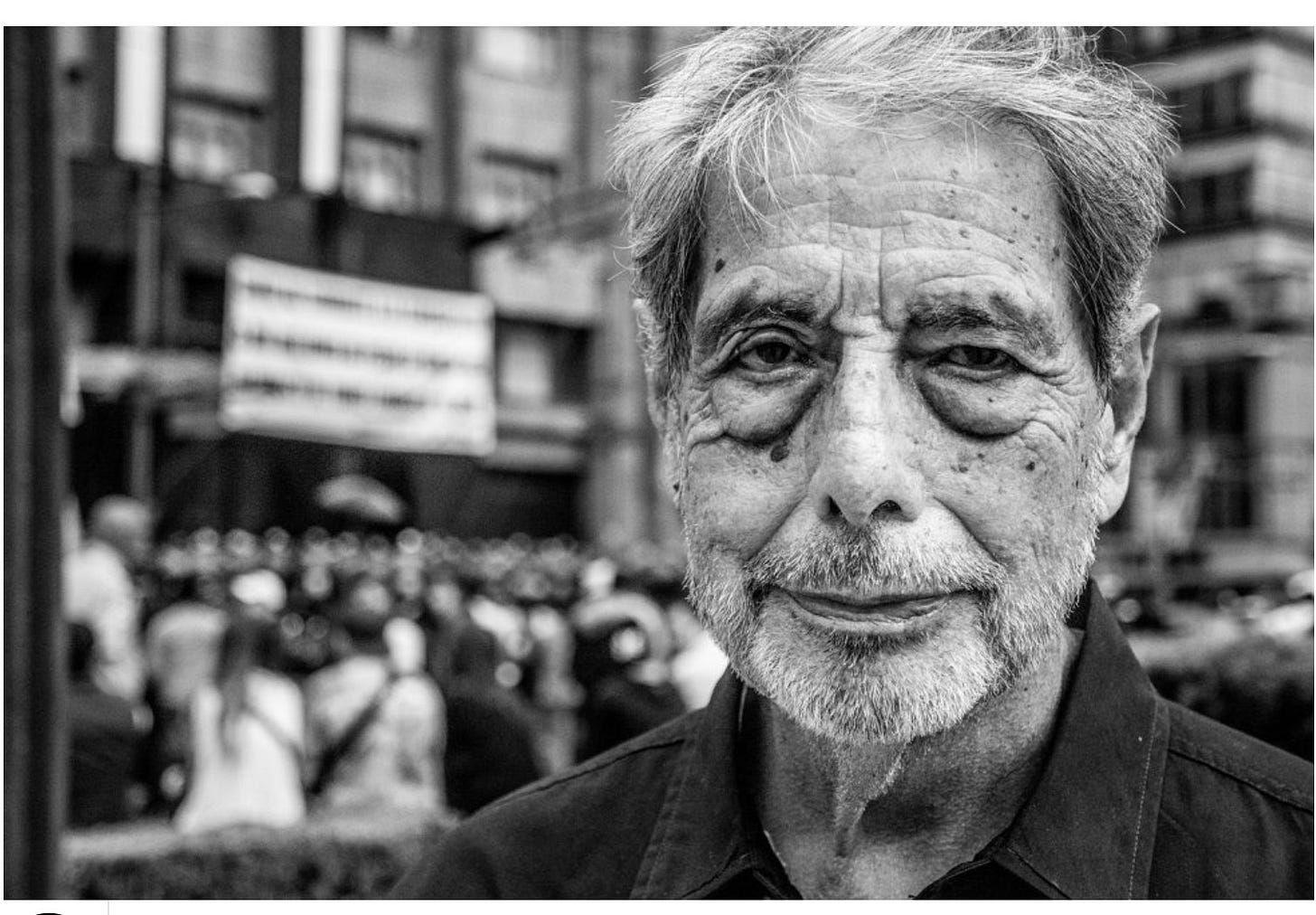
As one might imagine, the loss of these leaders seems to have done some damage to the movement, who’s recent activity seems to have been minimal. The group’s twitter account has been fairly silent since del Ángel’s death.
While the current status of the 400 Pueblos movement may not be as prominent as during its peak activism, their fight for land rights and justice remains unresolved. The movement persists in demanding restitution for the lands taken from them and holding the responsible parties accountable. Their continued presence serves as a reminder that the struggle for justice and equality is ongoing.
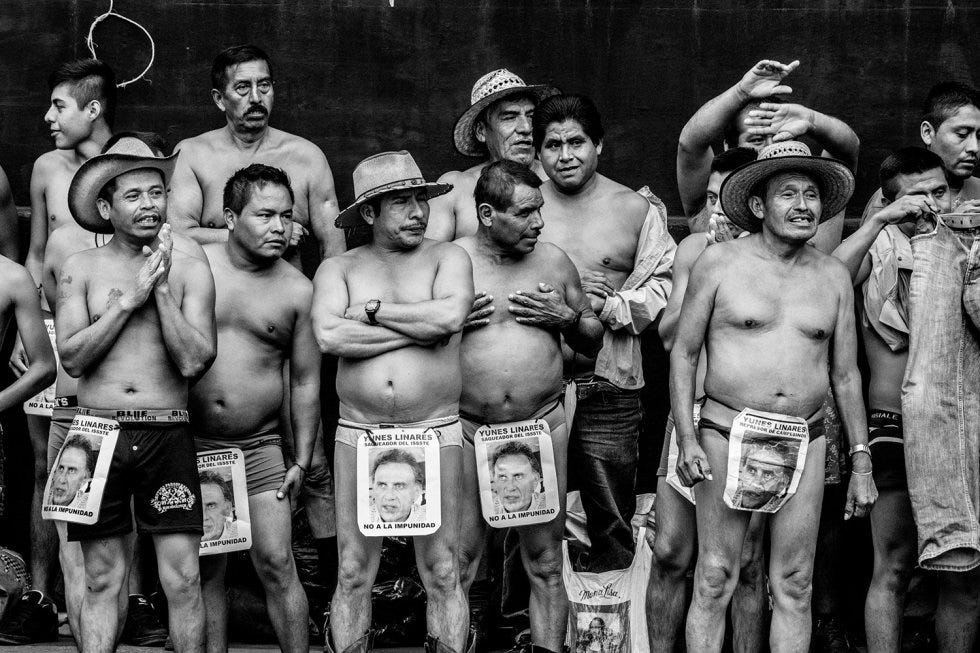
Power to the peasants
The nudity of the 400 Pueblos exemplifies the power of the raw human body as a form of resistance and a tool for raising awareness about social injustice. By employing nudity, they challenged societal norms, drew attention to government exploitation, and underscored the importance of indigenous rights and culture. Their unique journey within the realm of nude activism serves as a testament to the enduring spirit of the human quest for justice and equality. The 400 Pueblos’ willingness to strip away the confines of modesty and embrace the vulnerability of their naked bodies represents their unwavering commitment to their cause. 🪐

Cueto, Antonio. Dec 20, 2019. Members of ‘400 Pueblos’ take to Mexico City streets for land, workers’ rights. The ACC Star. https://accstar.org/2019/07/16/members-of-400-pueblos-take-to-mexico-city-streets-for-land-workers-rights/
Delgado, Ana Karina. Apr 19, 2016. Movimiento de los 400 Pueblos: Usar el cuerpo para pedir la tierra. Planeta Futuro. https://elpais.com/elpais/2016/04/18/planeta_futuro/1460996958_515477.html
Alvarez, Celeste. Jun 5, 2015. Mexican 400 Pueblos Movement: A Different Side Of Nude Protest. Neon Tommy. https://medium.com/neon-tommy/mexican-400-pueblos-movement-a-different-side-of-nude-protest-cf06f7955d58
Oct 23, 2014. Mujeres de los 400 Pueblos protestan desnudas contra Conagua. CIUDADANÍA EXPRESS. https://www.ciudadania-express.com/2014/10/23/mujeres-de-los-400-pueblos-protestan-desnudas-contra-conagua
Matilde Pérez U. Sep 7, 2009. Alfonsina: me encuero en la ciudad porque el gobierno nos niega la ropa de la tierra. La Jornada. Translated by Google. Emphasis added by author. https://www.jornada.com.mx/2009/09/07/politica/012n1pol
Jul 9, 2019. “FGE ejecuta órdenes de aprehensión ilegítimas contra 400 pueblos: César del Ángel” Source: YouTube
Apr 7, 2019. Detienen a líder de mujeres de "Los 400 Pueblos". La Silla Rota Veracruz. https://lasillarota.com/veracruz/estado/2019/7/4/detienen-lider-de-mujeres-de-los-400-pueblos-190584.html
May 7, 2019. Doble fracaso de la Fiscalía contra los 400 Pueblos. La Silla Rota Veracruz. https://lasillarota.com/veracruz/local/2019/7/5/doble-fracaso-de-la-fiscalia-contra-los-400-pueblos-190725.html
Aug 7, 2020. Muere César del Ángel Fuentes, líder de “Los 400 Pueblos”. El Universal. https://www.eluniversal.com.mx/estados/muere-cesar-del-angel-fuentes-lider-de-los-400-pueblos/
Morales, Erika. Jul 8, 2020. Muere César del Ángel Fuentes, líder de “Los 400 Pueblos”. Golpe Politico. https://golpepolitico.com/2020/07/08/muere-cesar-del-angel-fuentes-lider-de-los-400-pueblos/
Aug 24, 2021. Muere la líder de mujeres de Los 400 Pueblos. La Opinion. https://www.alcalorpolitico.com/informacion/fallece-alfonsina-la-lider-de-las-mujeres-de-los-400-pueblos-351238.html

